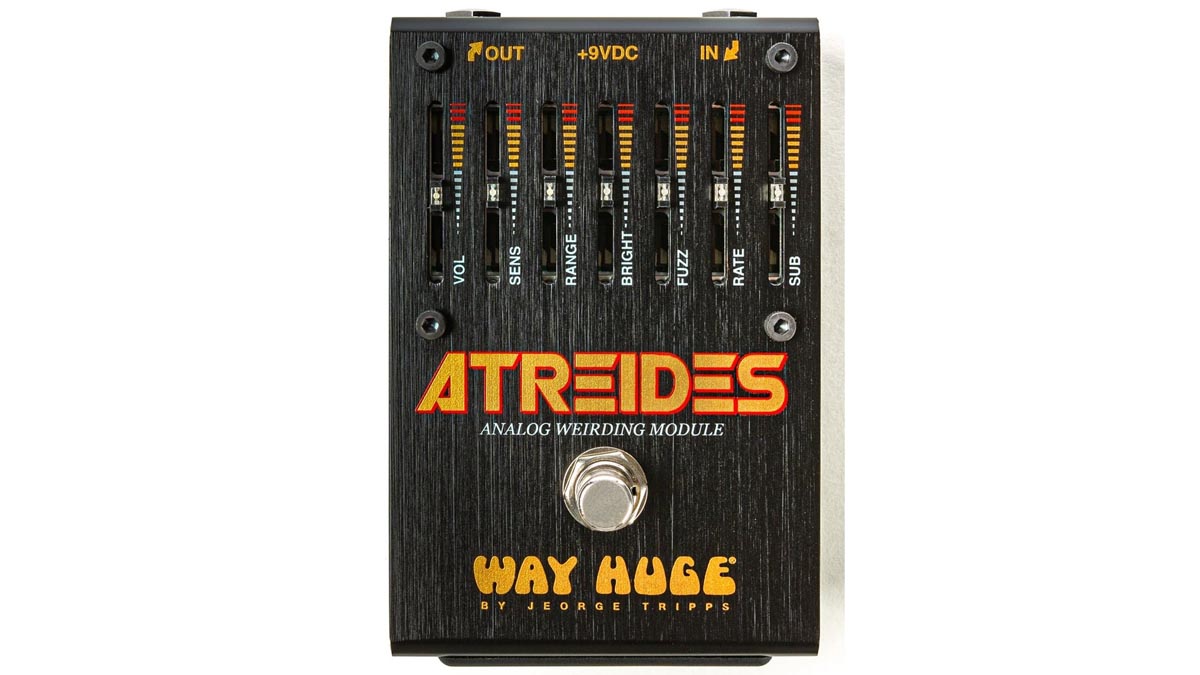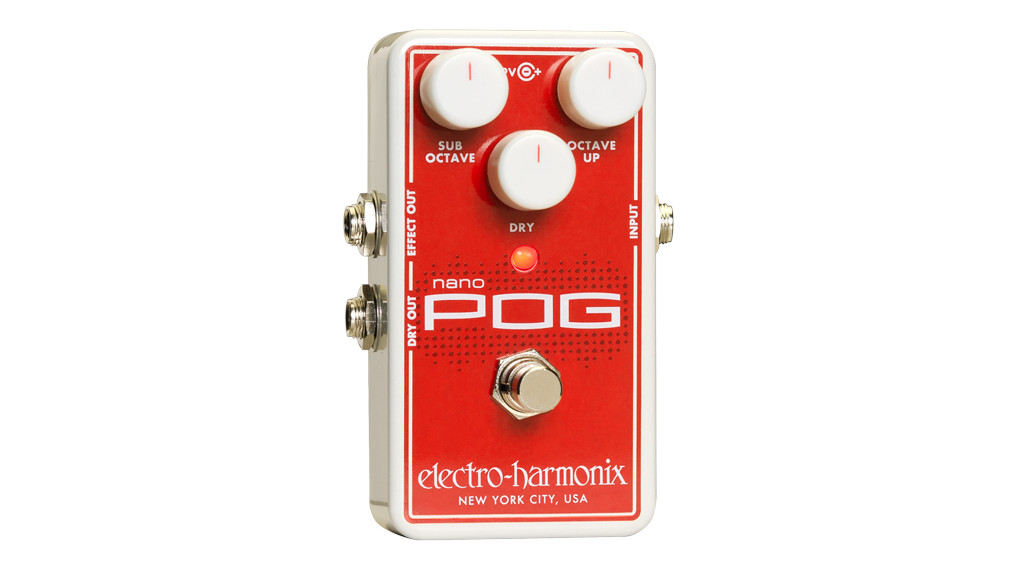MusicRadar Verdict
One for sending your tone through the Twilight Zone, the Atreides might not be every player's cup of tea but it's sure to gain a cult following with the sonically adventurous.
Pros
- +
Weird is good.
- +
There is nothing else quite like it.
- +
Well designed.
Cons
- -
Might be a little off-the-wall for many players.
- -
Like all synths, can be glitchy with certain playing styles.
MusicRadar's got your back
Way Huge Atreides: what is it?
What indeed is the Way Huge Atreides? We might never be able to do it justice in words – it is that kind of pedal – but Way Huge describes it as an 'Analog Weirding Module' and that sounds about right for a stompbox that eschews the typical control setup and packs envelope filter, fuzz, phaser and sub-octave effects into one compact enclosure.
Even for pedalboards crowded with exotic pedals, this is still something of the exotic. You'll notice the absence of any knobs. Way Huge has equipped the Atreides with a set of sliders instead, giving it the look of a common or garden equaliser pedal from a distance – but named for a Dune character, its effect on electric guitar tone is a lot more sci-fi, and there are '80s analogue synth tones inspired by the EHX Mini Synthesizer keyboard much loved by Eddie Van Halen.
There are seven sliders in total, with the midway point of their travel. They light up blue when the pedal is active, and in arranging the controls as sliders, it is actually a little easier to work out what you want the Atreides to do. In effect, you are mixing the various effects, using them in combination with each other for tones that can range from a simple boost or outer space synth craziness.

Let's look at them in turn. On the far left, the volume slider does just that, applying a boost or cut when the pedal is engaged. Set it in the midway point for unity gain. Next to the volume you'll find Sens and Range – sensitivity and range, of course – which control the envelope filter. In the middle position, there is a Bright control that behaves much as you would expect it to, adding a welcome dose of treble to the effects mix.
Meanwhile, Fuzz, as the name suggests, dials in a fairly animalistic fuzz sound, Rate controls the speed of the phaser with a trim pot located internally for adjusting feedback, and Sub brings in an octave down effect that can add some serious weight to your sound with one or two octaves available. A slide switch inside the enclosure lets you set it at one or two octaves down.
Way Huge Atreides: performance and verdict
With a pedal like the Atreides, you can just dive in and start experimenting. It's a lot of fun. The chances are you will stumble across something awesome or utterly unusable and that is part of the appeal. But once you've sent the dog running for cover with an octave down synth-fuzz, it pays to investigate each of the controls individually to see what it can do for you.
There is a lot to get into with the Atreides. You could lose weeks tweaking it. The first impressions of the unit tell us it is well made. The sliders are well-constructed and robust with a clear detent at the midpoint. That they light up is very handy indeed – the Atreides is the sort of pedal whose settings you want to keep an eye on.
Want all the hottest music and gear news, reviews, deals, features and more, direct to your inbox? Sign up here.

• Electro-Harmonix Nano POG
Now in its most compact incarnation yet, the Nano POG continues to handle like a champ, with infallible tracking and some of the most natural octaves you'll get out of a pedal-based pitch-shifter.
• Keeley Electronics Synth-1
In terms of tone, it’s thick, fuzzy and particularly tasty in the triangle mode with a slow attack. With the blend all the way up, we could see how this could become a trusted studio tool.
It's worth bearing in mind that when the Atreides is on, it is on. Things are happening. Adjust the volume to taste and it's time to bring the rest of the features into play. Some settings might freak you out. There's a glitchiness to some settings that work as an anarchic musical dynamic or is something to be mindful of as you play.
With the sub-octave effect in play, add a little fuzz, some phaser, you can have a thick tone for progressive lead tones. The more of the effects are dialled in, the more monophonic the performance, with single-note lines assuming such girth and weight that they might well occupy a similar space in the mix.
With the volume jacked, the fuzz dialled up, pushing the bright control to its extremes produces a nice, scratchy distortion that works well with chords and brings a lo-fi crunch to the mix. But the reality-altering capabilities of this pedal – named after the protagonist in Frank Herbert's Dune – are never too far from the surface.
Timid players and traditionalists should look elsewhere. But if you have developed a taste for nasty octave-fuzz sounds and like the idea of some analogue synth madness in your sound, you have to try one ASAP. It's the sort of pedal to pull rock players out of a rut. It's the kind of pedal that inspires new thinking on the instrument, maybe even a new sound altogether.
MusicRadar verdict: One for sending your tone through the Twilight Zone, the Atreides might not be every player's cup of tea but it's sure to gain a cult following with the sonically adventurous.
Way Huge Atreides: the web says
”There’s a certain dynamic response so you can dig in and ‘play’ the pedal, but there’s also gating built in so you can roll guitar volume back for staccato notes. As for the sounds, we quite liked the tone with just the sub-octave with a little of the fuzz and phaser mixed in for a fat fusion lead tone.
”Elsewhere, there’s some robust riffing sounds to be extracted, plus plenty of warbly, growly and spiky nastiness that’s possibly anathema to classic rock and blues purists, but maybe exactly what’s need for off-the-wall onstage impact.”
Guitarist
”The Atreides' tones range from arresting and unusual to downright deviant, but its sensitive, well-considered, and smartly designed features make the pedal surprisingly varied and forgiving. While the Atreides welcomes and rewards a chaotic approach to tone shaping, you can still craft precise tones with practice.”
Premier Guitar
Way Huge Atreides: hands-on demos
Guitarist
JHS Pedals
Sweetwater
PMTVUK
GAK
Jim Dunlop
Way Huge Atreides: specifications
- ORIGIN: USA
- TYPE: Analog Weirding Module pedal
- FEATURES: True bypass
- CONTROLS: 7x sliders: Vol, Sens, Range, Bright, Fuzz, Rate, Sub. Internal slide switch and trimpot, bypass footswitch
- CONNECTIONS: Standard input, standard output
- POWER: 9V battery or 9V DC adaptor 9mA
- DIMENSIONS: 80 (w) x 123 (d) x 65mm (h)
- CONTACT: Jim Dunlop
MusicRadar is the number one website for music-makers of all kinds, be they guitarists, drummers, keyboard players, DJs or producers...
- GEAR: We help musicians find the best gear with top-ranking gear round-ups and high-quality, authoritative reviews by a wide team of highly experienced experts.
- TIPS: We also provide tuition, from bite-sized tips to advanced work-outs and guidance from recognised musicians and stars.
- STARS: We talk to musicians and stars about their creative processes, and the nuts and bolts of their gear and technique. We give fans an insight into the craft of music-making that no other music website can.

